Abstract
Archaeological 3D digitization of skeletal elements is an essential aspect of the discipline. Objectives are various: archiving of data (especially before destructive sampling for biomolecular studies for example), study or for pedagogical purposes to allow their manipulation. As techniques are rapidly evolving, the question that arises is the use of appropriate methods to answer the different questions and guarantee sufficient quality of information. The combined use of different 3D technologies for the study of a single Mesolithic bone fragment from Brittany (France) is here an opportunity to compare different 3D digitization methods. This oldest human bone of Brittany, a clavicle constituted of two pieces, was dug up from the mesolithic shell midden of Beg-er-Vil in Quiberon and dated from ca. 8200 to 8000 years BP. They are bound to post-mortem processing, realized on fresh bone in order to remove the integuments, which it is necessary to better qualify. The clavicle was studied through a process that combines advanced 3D image acquisition, 3D processing, and 3D printing with the goal to provide relevant support for the experts involved in the work. The bones were first studied with a metallographic microscopy, scanned with a CT scan, and digitized with photogrammetry in order to get a high quality textured model. The CT scan appeared to be insufficient for a detailed analysis; the study was thus completed with a µ-CT providing a very accurate 3D model of the bone. Several 3D-printed copies of the collarbone were produced in order to support knowledge sharing between the experts involved in the study. The 3D models generated from µCT and photogrammetry were combined to provide an accurate and detailed 3D model. This model was used to study desquamation and the different cut marks, including their angle of attack. These cut marks were also studied with traditional binoculars and digital microscopy. This last technique allowed characterizing their type, revealing a probable meat cutting process with a flint tool. This work of crossed analyses allows us to document a fundamental patrimonial piece, and to ensure its preservation. Copies are also available for the regional museums.
1. Introduction
The methods for 3D digitisation of tangible cultural heritage are constantly being updated [1] both for scientific purposes to study bone pieces as in palaeopathology [2,3], and for educational purposes for exhibitions, museums [4,5] or conservation before destructive sampling (biomolecular studies for example) [6]. The choice of a method depends on the size of the object, the need for resolution and the portability of the scanning device [7]. 3D digitization methods applied to paleontology can be grouped into four categories. Widely used in many fields, photogrammetry is used as a first approach [8,9]. In addition, quite common in archaeology, lasergrammetry has been used for paleontological studies for over ten years [10,11]. Recently, structured-light 3D scanners in particular are increasingly used in this scientific discipline [12,13,14,15]. These scanners are equipped with an HD projector with a wide field of view, as well as glass panels for simplified calibration. They are fast, the scanning area is also quite large, but they are sensitive to the lighting conditions in a given environment and still cost a few thousand euros. For the precise study of the interior of the objects of study, micro computed tomography (µ-CT) scanning proves to be very appropriate [16,17,18], despite the very high acquisition cost. Microscopy, on the other hand, has recently undergone a revolution in the sense that it is now possible to produce 3D models of microscopic parts of objects. Indeed, 3D digitization applied to small and micro scaled objects is currently booming in industry [19], emerging in archaeology [20,21] and paleontology [22]. Studies in this field are also now using several of these methods, for example by combining photogrammetry and lasergrammetry [23,24], lasergrammetry and microscopy [25], or µ-CT and microscopy [26]. Their complementarity makes it possible to analyze the subjects of study at different levels of internal and external scales [27].
The first objective of using these 3D scanning tools is anatomical characterization of bones [28,29], including determination of sex [30] or taxonomic discrimination [21,31]. Because bones are unintentional witnesses to the events of a person’s life, the study of the injuries also represents a major scientific topic [32]. However, beyond the study of the owner of these anatomical remains, it is also very relevant to look into the alterations which occur since the death until the fossilization of bones [27], when they are used as tools [33], their means of conservation [34], and their disseminations [35]. In particular, the study of cut-marks has recently gained momentum in paleontology, building on previous experiences with archaeological analyses of metals [36] or carved rocks [37]. Concerning the killed animals, identifying the projectile from the impact marks can allow a better understanding of the hunting methods [38]. Then at the butchering stage, the determination of the tools used proves to be crucial and leads more and more studies of marks on the surface of the bones [9,23,24,39], but also of their internal structure [26]. The size of the bone does not seem to have an impact on these scientific issues [12], and the butchers may be animals [13,14]. The use of bone for artistic purposes also involves the analysis of cut-marks for gestural recognition [40]. When it comes to human remains [15] or traces [25], the issues are much the same. From a more global perspective, these issues are often linked to equifinality questions. This concept, introduced in 1987 [41], indicates that a specific type of alteration cannot be linked to a single actor, such as human or bear [22], a single behavior [42] or a single ecological context. The use of statistics on a large number of cut-marks allows to try to define potential multiple causes [27,43].
As with architectural buildings or artefacts, virtual reconstruction is also applied to bone structures [44,45]. As it is often the case at the end of the 3D production process, 3D printing finally completes some analysis [46] and reconstructions [47], especially for the teeth [48] whose 3D study has long interested scientists [49] because of their good preservation abilities [50].
The settlement of Beg-er-Vil at Quiberon (Brittany, France) [51] provides remarkable evidence of the lifestyles of the last maritime hunter-gatherers along the Atlantic coast, between 8200 to 8000 BP (Figure 1).

Figure 1.
(a) location of the study area (Morbihan, Brittany, France) in western Europe (b) Beg-Er-Vil site B located in relation to the main other Mesolithic sites with ancient shores (A: Téviec; C: Malvant; D: Port-Neuf at Hoëdic) (c) site excavation (© Grégor Marchand [52]).
The site was first excavated during the 1980s, and has undergone extensive excavation between 2012 and 2018, in order to anticipate the destruction of the site by marine erosion. The large amount of knapped lithic industries founded in the site, which are typological classifications of stone tools [53] as trapezoidal bitruncations, blade and bladelets retouched supports, can be associated to the second Mesolithic technical tradition of Brittany, also known as “Teviecian” [54]. This technocomplex covers the entire end of the Mesolithic sequence and develops throughout the 6th millennium cal BC: it is characterised by the dominant use of symmetrical trapezoids with abrupt retouching, some with concave truncations [55]. The Mesolithic settlement includes a level of shells [56], other detritus and at least two dwellings on the periphery. It was in the shell layer that some human remains were found, scattered among the garbage. In addition to a clavicle (Figure 2), there was a fragment of a skull and a fragment of a mandible. In a region characterized by acidic soils, the preservation of these bones is of great heritage interest, since they are the oldest human remains found in Brittany. At 17 km north of Beg-er-Vil, the Téviec cemetery also revealed a large quantity of human bones. In this shell midden, M. and S.-J. Péquart discovered 10 graves (for 23 individuals) grouped in a restricted space of about 50 m [57]. Dates by radiocarbon indicate that the deceased were placed between 5600 and 5300 BC, later than the settlement of Beg-er-Vil.
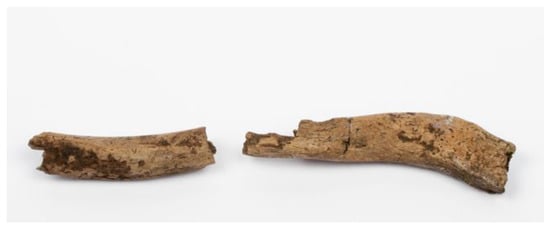
Figure 2.
The two pieces of the clavicle of Beg Er Vil site.
Scattered human remains are very common in Mesolithic settlements, with post-mortem treatment marks as well. It is difficult to determine the motivation for this. In the case of intimate mixing with animal bones, the hypothesis of cannibalism has been proposed [58,59,60]. However, is it only for food or does it have other symbolic virtues? We must keep in mind the possibility of other practices, such as trophies [61], the cult of relics [62], the accidental disruption of graves [63] dug in the very heart of the habitat.
The subject of our work is this clavicle, found split into two pieces, showing traces of cutting, but allowing neither statistical parametric tests and unambiguous interpretations, because their number is too low, nor DNA, because the bone is too altered. By combining with a classical anthropological study, 3D multi-scale digitisation, reconstruction and printing techniques, our objective was to characterize and document the anatomy of this Breton Mesolithic individual, as well as hypothetical tools and gestures used for the cutting of his/her bone remains.
2. Materials
This right clavicle is more preserved than the other bones mentioned above, which cannot be studied at present. It consists of two pieces, numbered 56-186-007-AG-22-122 and 56-186-007-AG-23-173 (Figure 3), discovered separately at a one meter distance from each other. The two pieces match, so they can be assembled in a single fragment of approximately 7 cm. The bone fracture followed the taphonomic processes and no human fracture on fresh bone is evidenced. The acromial and sternal extremities are missing and it may be noted a bone loss at the middle level of the diaphysis. The cortical bone is altered. The absence of epiphyses makes it impossible to determine the subject’s age at death. However, in view of the general morphology of the bone, we propose to classify it in the adult age group. Although the graceful appearance of the bone morphology could point to a female gender, the clavicle is also not a sufficiently diagnostic element for the determination of sex [64]. Indeed some studies try to determine sex from anthropometric dimensions of the clavicle, but this is on a targeted population [65,66], and we would have gone further on this question only if we had been able to have other analysable bones.
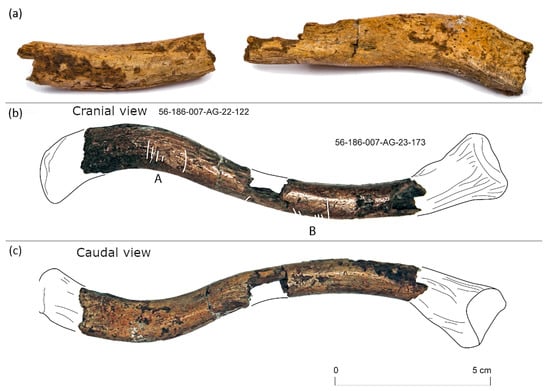
Figure 3.
Photos of the pieces (a), cranial with highlighted cut marks belonging to A/B groups (b) and caudal (c) view of the clavicle fragments.
Cut marks are also clearly visible on the surface of these bones. A series of 13 short but deep incisions, parallel and perpendicular to the diaphysis, is noted on the cranio-ventral face of the bone. No damage is noted on the caudal side. The profile of the incisions is rather V-shaped and more or less marked. Gathered in a group we called A, the six most lateral striae are very close together and probably correspond to the decarnation of the deltoid muscle, while the other seven, medial and gathered in a group we called B, correspond to the cutting of the attachments of the pectoralis major (Figure 3).
The six incisions of the first group (A) on the cranial side of the acromial half cut into the periosteum. Four of the five most lateral striae are identical, marked, parallel, perpendicular to the diaphysis and 5 mm long. They are spaced 1.5 mm apart. The fifth is thinner, more oblique, and fits without overlap between the second and third striae. A crushing of the periosteum, probably of taphonomic origin, prevents the piece from being read backwards. The sixth incision, 6 mm long, is 7 mm away from group A and is slightly curved.
The incisions of group B, noted on the sternal half, are numerous and more present on the cranio-ventral side of the specimen, all again perpendicular to the diaphysis. Several removals from the surface of the periosteum, subsequent to the cut marks, however, prevent precise reading, with only the compact bone appearing with its characteristic interstitial lamellar morphology. Only three thin, parallel, double incisions, 5 mm long, are noted on the posterior surface. The particular morphology of the striae, with their fine doubling, may characterise the type of tool used and the nature of its cutting edge. Elsewhere on the bone, the incisions are all distinct, composed of a single line, and despite their proximity, are arranged without any particular apparent regular spacing.
Between these two groups, a marked, isolated, 6.5 mm long incision is noted on the anterior surface, perpendicular to the diaphysis. It is slightly oblique from the outside to the inside and from the top to the bottom, the cranial part of the incision being more flared than the anterior part. This incision is located at the lateral end of the pectoralis major muscle. Medial to the diaphyseal break, the periosteum of the bone is absent, the compact bone and its relief in interstitial lamellae are clearly visible. Thus, if they existed, no cut mark can be seen at this location.
3. Methods
Our methodology for interactive digital introspection was developed as part of the INTROSPECT project aiming to develop new uses and tools for archaeologists using interactive digital introspection methods [67]. It is a research collaboration between researchers in computer science and archaeology made up of about fifteen people from France and Quebec. The scientific core of the project concerns the systematization of the relationship between the artifact, the archaeological context, the digital object and the virtual reconstruction of the archaeological context that represents it. Thus, the methodology aims to combine digitization and 3D visualization technologies, such as virtual reality, tangible interactions and 3D printing (Figure 4). To meet our goals, we used a wide spectrum of digitization technologies non-destructive as wide as possible, that is to say photogrammetry, computed tomography (CT), micro-computed tomography (µ-CT), metallographic and digital microscopy. We also adapted our uses of data processing tools according to the needs of archaeologists by combining 3D modeling, point cloud/mesh processing and photogrammetry softwares. The different 3D models produced during the study aimed to validate or invalidate archaeological hypotheses. In a second step, these 3D models were also used for the dissemination of knowledge to a wide audience. In this subsection, we will discuss the technical descriptions of the digitization tools and the software used. CT and µ-CT are described in the same paragraph because they belong to the same technological family.
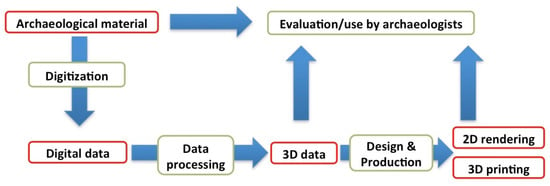
Figure 4.
Methodology of the interactive digital introspection project [67].
3.1. Metallographic Microscopy
The clavicle was first studied with a Unitron EXAMET-4 Metallurgical Microscope Series 14250/14251 to detect and identify traces that may correspond to cutting, made with a tool that was very sharp and thin. Precise 2d views were realized and are shown in the results.
3.2. Photogrammetry
For the photogrammetry of the clavicle, 121 photos for fragment 56-186-007-AG-22-122 and 94 for fragment 56-186-007-AG-23-173 were taken in July 2015, using a camera Canon EOS 7D EF100 mm f/2.8 L. The photos have a resolution of 3456 × 5184 pixels and have been taken indoors with flash and flash reflector umbrellas. The two bones have been planted head up and head down in Blu Tack adhesive, to get the best possible coverage. The photogrammetry of the clavicle was performed using Agisoft Metashape software (Figure 5) with the characteristics presented in the Table 1. “Cameras aligned” is the number of cameras for which the software was able to find position and orientation. “Tie points” is the number of points in a digital image that represent the same location in an adjacent image. “Dense cloud points” is the number of points in the dense cloud, calculated from the estimated camera positions, and for which program estimates depth information. “3D model faces” is the number of polygons in the mesh reconstructed from the dense cloud.
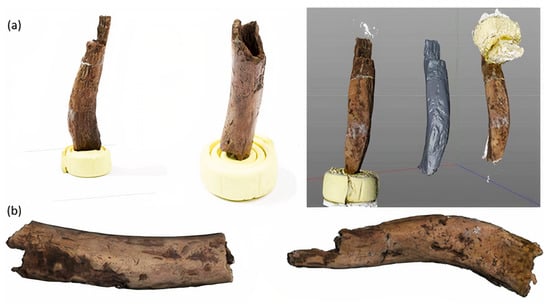
Figure 5.
Photogrammetry (a) and 3D cleaning and alignment (b).

Table 1.
Technical specifications of photogrammetry process produced with Agisoft Metashape.
The texture of the photogrammetry models has a good quality, but fails to provide the detail that metallographic microscopy allows. However, this first 3D digitization offered us a valuation support, and addressed our methodological choices for the rest of the process. With the Autodesk 3ds Max software, we then removed the 3D Blu Tack (Figure 5).
3.3. CT and µ-CT
To get more accurate meshes, although not textured, we put the clavicle in a CT-scan “Siemens SOMATOM sensation 16”. The scan constants were 120 kV, 250 mAs. The result allowed us to make precise measurements of the two pieces of the bone (Figure 6).

Figure 6.
Measurements on CT-scan meshes.
In order to get more precise data on the internal structure of the bone, we also put it in a X-ray microfocus CT system General Electric (formerly Phoenix) v—tome—x 240D. The scan constants were 120 kV, 700 µAs, with an acquisition time of 400 ms. The scan settings are shown in the Table 2. The software associated with the µ-CT also allowed an assisted refit of fragments (Figure 7).

Table 2.
Characteristics of CT and µ-CT.
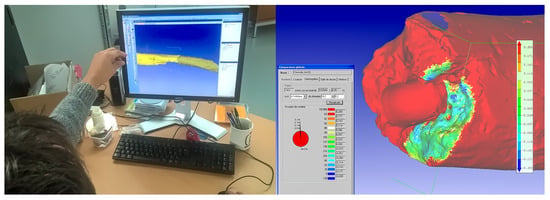
Figure 7.
Computer-assisted fragments matching.
So as to test the coherence of the assemblies resulting from photogrammetry and µ-CT, we aligned them manually with 3ds Max. In order to highlight some fine details, we also used the CloudCompare [68] ShadeVis plugin [69] on the meshes from µ-CT. Cloudcompare was also used to make the cross sections.
3.4. Digital Microscopy
The digital microscopy is the last digitization method we used to have more accurate meshes for the cuts. Because this microscope is already used in archeology [70], we used a Keyence VHX-5000. This is an all-in-one microscope that allows image capture and measurement. After adjusting the color balance, brightness and focus, it is possible to rotate the lens around the object, zoom in/out, and visualize a textured 3D model of the study area, and to extract cross-sections. Lens calibration was 1.13 mm and magnification varied from ×20 to ×200.
To perform the measurements, we used the software “VHX measurement data tabulation tool”, allowing 3D visualization, export of measurement data such as length and area in CSV format, but no 3D export [71]. To get 3D models comparable with the other models mentioned previously, we made photogrammetry with multiple screenshots from the 3D VHX viewer. For one cut whose mark was hard to see, we used Photoshop filters and Dstrech software [72] on textures to highlight details and accentuate edges.
4. Results
4.1. Locations of Cuts
The first metallographic microscopic study revealed an emaciation which highlights an impact on the superior and anterior side of the clavicle. This reflects a repetitive and localized gesture in particular areas, and cutting of the deltoid and pectoralis major muscles (Figure 8). The preliminary archeological analysis concerns the positions of anthropic cuts on the clavicle. Using the CloudCompare ShadeVis plugin on µ-CT meshes, the eroded zones caused by a desquamation process [73,74] could be highlighted. These areas, marked in blue in Figure 8, result from the taphonomic process and can be excluded from any anthropic phenomenon.

Figure 8.
(a) metallographic microscopic study of the clavicle (b) 3D visualization of desquamation.
In order to be sure not to miss a cut mark, clearly visible on the photogrammetry texture, but perhaps less easily detectable on the µ-CT, we wanted to align the meshes from these two sources. To do this, we used the automatic alignment tool of Autodesk 3ds Max software and then made some manual adjustments. The result is shown in Figure 9, and we found it satisfactory, because all the cut marks visible on the photogrammetric mesh were also detectable on the µ-CT mesh.

Figure 9.
Alignment of assemblies resulting from photogrammetry and µ-CT.
To test a possible difference in the orientation of the cuts on µ-CT meshes, we first drew a curve through centers of small cross sections of the bone. Then each center of mass of a cut was projected orthogonally on this spline. In Figure 10, the first row shows different viewpoints and zoom levels of one of the cuts (a,b,c,d). At these same viewpoints with 3ds Max, the following rows show in the order the manual selection of polygons on the cuts (e,f,g,h), the design of a flattened blue mark corresponding to this selection (i,j,k,l) and their projection on the spline (m,n,o,p). This representation allows us to see clearly the two groups of cuts A and B (Figure 3) with a different orientation suggesting a possible rotation of the bone during the cutting process performed by the Mesolithic operator. As mentioned at the beginning of the study, we had identified 13 cuts on real bone. Thanks to a second visual study on the real clavicle, helped by the 3D views of the cut marks, we were able to identify 14 other small cuts. The analysis of these locations confirmed the precise repetition of the gesture, suggesting that the operator had for objective to reflect the teguments. Because there is no axis change for the cuts, we can think that the operator was rather self-confident and did not make a rework or hammering.
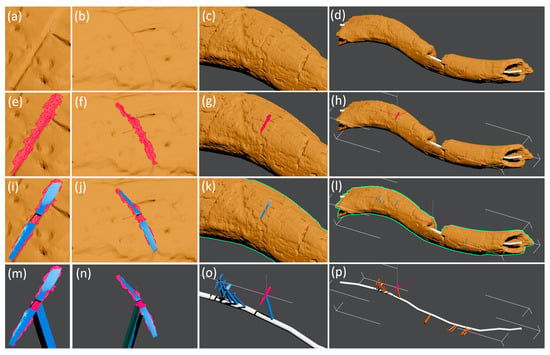
Figure 10.
3D design method from different viewpoints of orthographic projection of the centers of the traces on a central spline of the bone: cut location (a–d), manual selection of polygons on the cut (e–h), design of a flattened blue mark corresponding to this selection (i–l) and the projection on the spline (m–p).
4.2. Morphological Analysis
The resulting meshes from both tomography technologies have substantially the same number of faces, but the cuts appear much more clearly on the meshes from the µ-CT, thanks to a better resolution. Indeed, we used the maximum spatial resolution of 0.5 mm [75] for CT scan, and a resolution of 78.1 µm for µ-CT. To analyze as precisely as possible the morphology of the cuts, we focused on the mesh from the µ-CT, then on the different renderings obtained with the digital microscope. The goal was to get both 3D and cross sections.
First on µ-CT mesh with Cloudcompare, we cut large sections on which we thought we could observe cutting marks. By applying a color gradient with 3ds Max, we highlighted some cuts (Figure 11). We then exported these sections into Cloudcompare, to subsample point clouds on meshes and created cross sections (Figure 11). Compared to those obtained directly from the proprietary software of the digital microscope, the result is unsatisfactory for archaeologists, because the cross sections generated are too smooth and not sufficiently accurate.
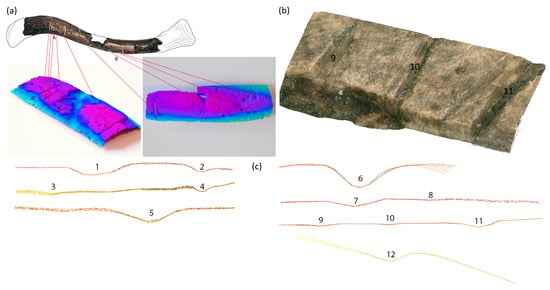
Figure 11.
3d meshes of portions containing cut marks from µ-CT (a), digital microscope digitization of 3 of them (b) and resulting cross sections (c).
In order to compare the cuts between them, we tried to produce a global view with images from the digital microscope (Figure 12). This shows textured sections associated with cross-sectional views of the contour lines of sections (a). One-line cross sections are also shown (b). The labels consist of the group letter (A or B) and the number of the cut mark. To produce this figure, we used only the sections obtained from the photogrammetries made with the digital microscope images. The references of the cuts are used several times to associate the images with each other. We were not able to clearly represent the cuts B12 to B17 because the images used for photogrammetry did not allow the creation of precise meshes. From this global view reflecting intentional repeated movements, these cuts are likely to be the evidence of human post-mortem interaction. The tool used had to be very sharp and thin, such as a coarse lithic flake or a chisel.

Figure 12.
Global view of sections obtained from the photogrammetries made with the digital microscope images: textured sections associated with cross-sectional views of the contour lines of sections (a) and one-line cross sections are also shown (b).
4.3. 3D Printing
A further scope of this work was 3d printing. At 1:1 scale, the printing of this mesh does not allow the correct readability of cuts. For this reason, we printed only the bone mesh, without the cuts, and then annotated it to show the cuts and their references (Figure 13). However, with the very detailed 3D meshes of cuts from digital microscope, and positioned on the bone, it would be also possible to print the whole on a bigger scale that would allow scientists to read the cuts easily.

Figure 13.
1:1 scale printing of the bone with annotations.
5. Discussion
The different 3D digital technologies used in this work, CT, µ-CT, photogrammetry, microscopy, and 3D printing, offered added value at two levels. First, they improved the scientific process in the study of the object by considerably increasing the number of observations. From 13 cut marks observed with the naked eye, the 3D visualizations allowed to determine 14 others, arriving at a total of 27 incisions. The precise repetition of the gesture suggests that the operator’s aim was to recline the integuments. The absence of changes in the axis of the traces indicates a rather self-confident operator, with no resumption or relentlessness in his work. The 6.5 mm long incision may be caused by the operator’s final move to recline the whole. Except for the double incisions, the tool used had to be very sharp and fine, such as a piece of rough flint or a chisel. Perhaps the same tool, broken or chipped during the operation, was used for the incisions observed on the posterior face in group B, thus generating the duplication of the cutting edge.
Secondly, it opened innovative opportunities in the mediation activity to disseminate the results to a wide audience by proposing a printable model. The use of new technologies, such as 3D modeling of the remains allows us to achieve a long-term protection of these fragile remains [34,76]. µ-CT presents a real advantage for precise meshes and the study of the state of preservation/internal degradation of the bone. Photogrammetry is useful for texture and microscopy for the study of cuts. Then, the combination of these techniques makes it possible to reinforce the argumentation for the expression of different hypotheses (two pieces of the same bone, traces of work of voluntary decarnation, with several axes of cuts). However and unlike photogrammetry, CT [77] has some impact on DNA, which requires precautions when using this technology on organic material such as human remains. In our case, the state of preservation of the bones did not allow to perform DNA analysis, and the pieces were already been highly manipulated and patched up with resin when discovered in the 1980s. Furthermore, we used low intensity and voltage for both CT and µ-CT.
We did not use structured light scanners, which sometimes cause distortion problems that are currently being resolved [78]. These are also being tested for the analysis of tiny fossilised elements [79] and we will look at the use of these devices. Lasergrammetry is thus part of our prospects.
3D printing has served as a support for annotations for tracking the study of traces. This use of 3D printing is little explored at the moment, but the routine use of this technology makes it possible to produce easily and inexpensively copies of objects and to use them as a support for sketches, annotations of work under study, such as a draft sheet, with the advantage of a physical 3D representation very easily understandable. These 3D prints are already used to constitute reference collections for education [80,81] or for particular collections like pathological or paleoanthropological bones [82]. Figure 14 attempts to summarise the contribution of each technique and their combination in relation to the different objectives expressed above.
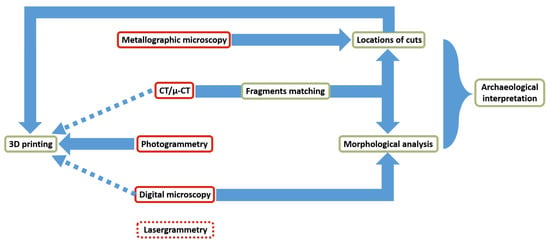
Figure 14.
Summary of technologies used (in red), their links (blue solid lines) with the objectives (in green) and potential prospects (dashes).
We think that our work on the Beg-er-Vil collarbone validated our approach. However it needs to be applied to many other case studies, in connection with future developments in these technologies, in order to be firmly established in anthropological practices, and in other scientific disciplines involving the study of cut marks or artworks. For the time being, no traces of cutting have been reported with the Téviec cemetery, but rigorous scanning and analysis must be carried out to document this exceptional heritage complex on a European scale. It would be very important to focus the analysis on the kinematics of such cuts and on the existence of any particular funeral traditions.
The integration in virtual reality of archaeological elements at small and microscopic scales is finally a real challenge [83]. This includes the study of pollens, microremains, insects for archaeoentomology, and of course cut marks. The interactions of a user within a virtual archaeological environment, at different scales, would allow the linking of these elements and thus the construction of reasoning.
6. Conclusions
In this article, we describe a combination of digital 3D technologies for the study of the oldest bone found in Brittany, a clavicle dating from the Mesolithic. These 3D views confirmed the post-mortem intervention on the bone. From the methodological point of view, it seemed interesting not to attempt hypotheses of morphological reconstitutions, which can sometimes be hazardous, but to think about practice of past human activity.
Furthermore, the 3D analysis of the cut marks brings clear data of the motion and gesture. The implement of this methodology, crossing with multidisciplinary approach as the study of the use wears of lithic tools, could provide new and valuable data about the post-mortem practices in Beg-er-Vil.
Author Contributions
Excavation and archaeological study, G.M. and J.C.G.; anthropological study, R.C.; methodology, J.-B.B., R.G., V.G. and R.C.; 3D productions and renderings, J.-B.B., A.G. and R.G.; writing—original draft preparation, J.-B.B., R.C., G.M., R.G., V.G., J.C.G. and A.G.; writing—review and editing, J.-B.B., R.C., G.M., R.G., V.G., J.C.G. and A.G.; lead of the INTROSPECT project, V.G.; responsibility for the INTROSPECT project, V.G., R.G. and G.M. All authors have read and agreed to the published version of the manuscript.
Funding
This research was funded by the “Agence nationale de la recherche” (ANR-16-FRQC-315 0004) with the INTROSPECT and the European Union’s Horizon 2020 research and innovation programme under the Marie Skłodowska-Curie (AIDE project, grant agreement n° 897565).
Acknowledgments
The authors wish to thank Guillermo Andrade Barroso, from IRISA/Inria for his work on the 3D printing productions. They also would like to thank Mathilde Paradis, a student in her second year of 3D production at the MJM Graphic Design School in Rennes, for her help with the 3D cleaning and alignment of the meshes resulting from the photogrammetry. Finally, they would like to warmly thank the reviewers for the quality and accuracy of their comments.
Conflicts of Interest
The authors declare no conflict of interest.
References
- Adamopoulos, E.; Rinaudo, F.; Ardissono, L. A critical comparison of 3D digitization techniques for heritage objects. ISPRS Int. J. Geo-Inf. 2021, 10, 10. [Google Scholar] [CrossRef]
- Miccichè, R.; Carotenuto, G.; Sìneo, L. The utility of 3D medical imaging techniques for obtaining a reliable differential diagnosis of metastatic cancer in an Iron Age skull. Int. J. Paleopathol. 2018, 21, 41–46. [Google Scholar] [CrossRef] [PubMed]
- Villa, C.; Frohlich, B.; Lynnerup, N. The Role of Imaging in Paleopathology. In Ortner’s Identification of Pathological Conditions in Human Skeletal Remains; Elsevier: Amsterdam, The Netherlands, 2019; pp. 169–182. [Google Scholar]
- Beer, S. Digital heritage museums and virtual museums. In Proceedings of the 2015 Virtual Reality International Conference, Laval, France, 8–10 April 2015; pp. 1–4. [Google Scholar]
- Bérubé, P. Vers une Muséographie Numérique: L’Impression 3D en tant que Dispositif de Traduction auprès de Publics Malvoyants et Aveugles. Master’s Thesis, Université de Montréal, Montreal, QC, Canada, 2018. [Google Scholar]
- Kuzminsky, S.C.; Gardiner, M.S. Three-dimensional laser scanning: Potential uses for museum conservation and scientific research. J. Archaeol. Sci. 2012, 39, 2744–2751. [Google Scholar] [CrossRef]
- Budak, I.; Santosi, Z.; Stojakovic, V.; Korolija Crkvenjakov, D.; Obradovic, R.; Milosevic, M.; Sokac, M. Development of Expert System for the Selection of 3D Digitization Method in Tangible Cultural Heritage. Teh. Vjesn. 2019, 26, 837–844. [Google Scholar]
- Falkingham, P.L. Acquisition of high resolution three-dimensional models using free, open-source, photogrammetric software. Palaeontol. Electron. 2012, 15, 15. [Google Scholar] [CrossRef]
- Yravedra, J.; Maté-González, M.Á.; Courtenay, L.A.; López-Cisneros, P.; Estaca-Gómez, V.; Aramendi, J.; de Andrés-Herrero, M.; Linares-Matás, G.; Aguilera, D.G.; Álvarez-Alonso, D. Approaching raw material functionality in the Upper Magdalenian of Coímbre cave (Asturias, Spain) through geometric morphometrics. Quat. Int. 2019, 517, 97–106. [Google Scholar] [CrossRef]
- Niven, L.; Steele, T.E.; Finke, H.; Gernat, T.; Hublin, J.J. Virtual skeletons: Using a structured light scanner to create a 3D faunal comparative collection. J. Archaeol. Sci. 2009, 36, 2018–2023. [Google Scholar] [CrossRef]
- Errickson, D.; Grueso, I.; Griffith, S.; Setchell, J.; Thompson, T.; Thompson, C.; Gowland, R.L. Towards a Best Practice for the Use of Active Non-contact Surface Scanning to Record Human Skeletal Remains from Archaeological Contexts. Int. J. Osteoarchaeol. 2017, 27, 650–661. [Google Scholar] [CrossRef]
- Maté-González, M.Á.; Courtenay, L.A.; Aramendi, J.; Yravedra, J.; Mora, R.; González-Aguilera, D.; Domínguez-Rodrigo, M. Application of geometric morphometrics to the analysis of cut mark morphology on different bones of differently sized animals. Does size really matter? Quat. Int. 2019, 517, 33–44. [Google Scholar] [CrossRef]
- Rodríguez-Alba, J.J.; Linares-Matás, G.; Yravedra, J. First assessments of the taphonomic behaviour of jaguar (Panthera onca). Quat. Int. 2019, 517, 88–96. [Google Scholar] [CrossRef]
- Arriaza, M.C.; Aramendi, J.; Maté-González, M.Á.; Yravedra, J.; Baquedano, E.; González-Aguilera, D.; Domínguez-Rodrigo, M. Geometric-morphometric analysis of tooth pits and the identification of felid and hyenid agency in bone modification. Quat. Int. 2019, 517, 79–87. [Google Scholar] [CrossRef]
- Aramendi, J.; Arriaza, M.C.; Yravedra, J.; Maté-González, M.Á.; Ortega, M.C.; Courtenay, L.A.; González-Aguilera, D.; Gidna, A.; Mabulla, A.; Baquedano, E.; et al. Who ate OH80 (Olduvai Gorge, Tanzania)? A geometric-morphometric analysis of surface bone modifications of a Paranthropus boisei skeleton. Quat. Int. 2019, 517, 118–130. [Google Scholar] [CrossRef]
- Papageorgopoulou, C.; Kuhn, G.; Ziegler, U.; Rühli, F.J. Diagnostic morphometric applicability of confocal laser scanning microscopy in Osteoarchaeology. Int. J. Osteoarchaeol. 2010, 20, 708–718. [Google Scholar] [CrossRef]
- Boschin, F.; Zanolli, C.; Bernardini, F.; Princivalle, F.; Tuniz, C. A look from the inside: microCT analysis of burned bones. Ethnobiol. Lett. 2015, 6, 258–266. [Google Scholar] [CrossRef]
- Uldin, T. Virtual anthropology—A brief review of the literature and history of computed tomography. Forensic Sci. Res. 2017, 2, 165–173. [Google Scholar] [CrossRef] [PubMed]
- Galantucci, L.M.; Guerra, M.G.; Lavecchia, F. Photogrammetry applied to small and micro scaled objects: A review. In Proceedings of the International Conference on the Industry 4.0 Model for Advanced Manufacturing, Belgrade, Serbia, 1–4 June 2020; Springer: Berlin/Heidelberg, Germany, 2020; pp. 57–77. [Google Scholar]
- Peacock, E.; Ryan, T.M. Scaling up, scaling down: Experiments with high resolution computed tomography scanning of microartefacts. Acta Archaeol. 2018, 89, 193–206. [Google Scholar] [CrossRef]
- Braga, J.; Zimmer, V.; Dumoncel, J.; Samir, C.; De Beer, F.; Zanolli, C.; Pinto, D.; Rohlf, F.J.; Grine, F.E. Efficacy of diffeomorphic surface matching and 3D geometric morphometrics for taxonomic discrimination of Early Pleistocene hominin mandibular molars. J. Hum. Evol. 2019, 130, 21–35. [Google Scholar] [CrossRef]
- Rosell, J.; Blasco, R.; Arilla, M.; Fernández-Jalvo, Y. Very human bears: Wild brown bear neo-taphonomic signature and its equifinality problems in archaeological contexts. Quat. Int. 2019, 517, 67–78. [Google Scholar] [CrossRef]
- Linares-Matás, G.J.; Yravedra, J.; Maté-González, M.Á.; Courtenay, L.A.; Aramendi, J.; Cuartero, F.; González-Aguilera, D. A geometric-morphometric assessment of three-dimensional models of experimental cut-marks using flint and quartzite flakes and handaxes. Quat. Int. 2019, 517, 45–54. [Google Scholar] [CrossRef]
- López-Cisneros, P.; Linares-Matás, G.; Yravedra, J.; Maté-González, M.Á.; Estaca-Gómez, V.; Mora, R.; Aramendi, J.; Asensio, J.A.R.; Barrera-Logares, J.M.; Aguilera, D.G. Applying new technologies to the taphonomic study of La Lluera (Asturias, Spain). Geometric morphometrics and the study of bone surface modifications (BSM). Quat. Int. 2019, 517, 107–117. [Google Scholar] [CrossRef]
- Courtenay, L.A.; Yravedra, J.; Huguet, R.; Ollé, A.; Aramendi, J.; Maté-González, M.Á.; González-Aguilera, D. New taphonomic advances in 3D digital microscopy: A morphological characterisation of trampling marks. Quat. Int. 2019, 517, 55–66. [Google Scholar] [CrossRef]
- Bello, S.M.; Galway-Witham, J. Bone taphonomy inside and out: Application of 3-dimensional microscopy, scanning electron microscopy and micro-computed tomography to the study of humanly modified faunal assemblages. Quat. Int. 2019, 517, 16–32. [Google Scholar] [CrossRef]
- Maté-González, M.Á.; González-Aguilera, D.; Linares-Matás, G.; Yravedra, J. New technologies applied to modelling taphonomic alterations. Quat. Int. 2019, 517, 4–15. [Google Scholar] [CrossRef]
- Cunningham, J.A.; Rahman, I.A.; Lautenschlager, S.; Rayfield, E.J.; Donoghue, P.C. A virtual world of paleontology. Trends Ecol. Evol. 2014, 29, 347–357. [Google Scholar] [CrossRef]
- Robedizo, B.P. The identifiability of Osteological Traits on 3D Models of Human Skeletal Remains. Master’s Thesis, Lund University, Lund, Sweden, 2016. [Google Scholar]
- Gamble, J.; Blackburn, A.; Hoppa, R.D. Congruence of Methods for Determination of Sex using Real, Virtual and 3-D Printed Specimens. Revive Past 2011, 132. [Google Scholar] [CrossRef]
- Barreau, J.B.; Le Maire, M.; Bourbouze, G. Study of the identity of a Breton mammoth from flattened tusk pieces tomography. In Proceedings of the 26th EAA Annual Meeting, Budapest, Hungary, 26–30 August 2020. [Google Scholar]
- Urbanová, P.; Ross, A.H.; Jurda, M.; Šplíchalová, I. The virtual approach to the assessment of skeletal injuries in human skeletal remains of forensic importance. J. Forensic Leg. Med. 2017, 49, 59–75. [Google Scholar] [CrossRef] [PubMed]
- Martisius, N.L.; Sidéra, I.; Grote, M.N.; Steele, T.E.; McPherron, S.P.; Schulz-Kornas, E. Time wears on: Assessing how bone wears using 3D surface texture analysis. PLoS ONE 2018, 13, e0206078. [Google Scholar] [CrossRef]
- Dellù, E.; Sciatti, A. Care of ancient human remains. Conservation and management with 3d modeling and dbms. In Proceedings of the ARQUEOLÓGICA 2.0-9th International Congress & 3rd GEORES-GEOmatics and pREServation, Valencia, Spain, 26–28 April 2021; pp. 414–426. [Google Scholar]
- Hassett, B.R. Which Bone to Pick: Creation, Curation, and Dissemination of Online 3D Digital Bioarchaeological Data. Archaeologies 2018, 14, 231–249. [Google Scholar] [CrossRef]
- Figueiredo, E.; Silva, R.J.; Araújo, M.F.; Fernandes, F.M.B. Multifocus optical microscopy applied to the study of archaeological metals. Microsc. Microanal. 2013, 19, 1248–1254. [Google Scholar] [CrossRef]
- Zotkina, L. Le bison de La Grèze (Marquay, Dordogne, France) sous le microscope. PALEO Rev. D’Archeologie Prehist. 2016, 27, 307–320. [Google Scholar] [CrossRef]
- Duches, R.; Nannini, N.; Romandini, M.; Boschin, F.; Crezzini, J.; Peresani, M. Identification of Late Epigravettian hunting injuries: Descriptive and 3D analysis of experimental projectile impact marks on bone. J. Archaeol. Sci. 2016, 66, 88–102. [Google Scholar] [CrossRef]
- Moretti, E.; Arrighi, S.; Boschin, F.; Crezzini, J.; Aureli, D.; Ronchitelli, A. Using 3D microscopy to analyze experimental cut marks on animal bones produced with different stone tools. Ethnobiol. Lett. 2015, 6, 267–275. [Google Scholar] [CrossRef]
- Bello, S.M.; De Groote, I.; Delbarre, G. Application of 3-dimensional microscopy and micro-CT scanning to the analysis of Magdalenian portable art on bone and antler. J. Archaeol. Sci. 2013, 40, 2464–2476. [Google Scholar] [CrossRef]
- Lyman, R.L. Archaeofaunas and butchery studies: A taphonomic perspective. Adv. Archaeol. Method Theory 1987, 10, 249–337. [Google Scholar]
- Domínguez-Rodrigo, M.; Saladié, P.; Cáceres, I.; Huguet, R.; Yravedra, J.; Rodríguez-Hidalgo, A.; Martín, P.; Pineda, A.; Marín, J.; Gené, C.; et al. Use and abuse of cut mark analyses: The Rorschach effect. J. Archaeol. Sci. 2017, 86, 14–23. [Google Scholar] [CrossRef]
- Maté-González, M.Á.; Aramendi, J.; González-Aguilera, D.; Yravedra, J. Statistical comparison between low-cost methods for 3D characterization of cut-marks on bones. Remote Sens. 2017, 9, 873. [Google Scholar] [CrossRef]
- Fantini, M.; de Crescenzio, F.; Persiani, F.; Benazzi, S.; Gruppioni, G. 3D restitution, restoration and prototyping of a medieval damaged skull. Rapid Prototyp. J. 2008, 14, 318–324. [Google Scholar] [CrossRef]
- Been, E.; Gómez-Olivencia, A.; Kramer, P.A.; Barash, A. 3D reconstruction of spinal posture of the Kebara 2 Neanderthal. In Human Paleontology and Prehistory; Springer: Berlin/Heidelberg, Germany, 2017; pp. 239–251. [Google Scholar]
- Allard, T.T. The Role of 3D Printing in Biological Anthropology. Master’s Thesis, University of Manitoba, Winnipeg, Manitoba, 2006. [Google Scholar]
- Almeida, F.; Bártolo, P.; Alves, N.; Almeida, H.; Ponce de Léon, M.; Zollikofer, C.; Pierson, B.; Serra, P.; Duarte, C.; Trinkaus, E.; et al. The Lapedo Child Reborn: Contributions of CT Scanning and Rapid Prototyping for an Upper Paleolithic Infant Burial and Face Reconstruction. The Case of Lagar Velho Interpretation Centre, Leiria, Portugal. In VAST 2007: Future Technologies to Empower Heritage Professionals: Short and Project Papers from Vast2007; EPOCH Publication: Archaeolingua, Budapest, 2007; pp. 69–73. [Google Scholar]
- Fiorenza, L.; Yong, R.; Ranjitkar, S.; Hughes, T.; Quayle, M.; McMenamin, P.G.; Kaidonis, J.; Townsend, G.C.; Adams, J.W. The use of 3D printing in dental anthropology collections. Am. J. Phys. Anthropol. 2018, 167, 400–406. [Google Scholar] [CrossRef]
- Mafart, B.Y.; Delingette, H.; Subsol, G. Three-Dimensional Imaging in Paleoanthropology and Prehistoric Archaeology; Archaeopress: Oxford, UK, 2002. [Google Scholar]
- Turner-Walker, G. The chemical and microbial degradation of bones and teeth. Adv. Hum. Palaeopathol. 2008, 592, 3–29. [Google Scholar]
- Marchand, G.; Dupont, C.; Laforge, M.; Le Bannier, J.C.; Netter, C.; Nukushina, D.; Onfray, M.; Querré, G.; Quesnel, L.; Stéphan, P. Before the spatial analysis of Beg-er-Vil: A journey through the multiple archaeological dimensions of a Mesolithic dwelling in Atlantic France. J. Archaeol. Sci. Rep. 2018, 18, 973–983. [Google Scholar] [CrossRef]
- Marchand, G.; Dupont, C. Domestic life by the ocean: Beg-er-Vil, c. 6200–6000 cal BC. In Foraging Assemblages; Borić, D., Antonović, D., Mihailović, B., Eds.; Serbian Archaeological Society: Belgrade, Serbia; The Italian Academy for Advanced Studies in America, Columbia University: New York, NY, USA, 2021; Volume 1, pp. 191–197. [Google Scholar]
- Clarke, D.L. Analytical Archaeology; Columbia University Press: New York, NY, USA, 1978. [Google Scholar]
- Rozoy, J.G. Les Derniers Chasseurs: L’Epipaléolithique en France et en Belgique: Essai de Synthèse; Cambridge University Press: London, UK, 1978; Volume 2. [Google Scholar]
- Dupont, C.; Marchand, G.; Carrión Marco, Y.; Desse-Berset, N.; Gaudin, L.; Gruet, Y.; Marguerie, D.; Oberlin, C. Beg-an-Dorchenn (Plomeur, Finistère): Une fenêtre ouverte sur l’exploitation du littoral par les peuples mésolithiques du VI e millénaire dans l’Ouest de la France. In Bulletin de la Société préhistorique Française; Société Préhistorique Française: Paris, France, 2010; pp. 227–290. [Google Scholar]
- Dupont, C.; Marchand, G. New paradigms in the exploitation of Mesolithic shell middens in Atlantic France: The example of Beg-er-Vil, Brittany. Quat. Int. 2021, 584, 59–71. [Google Scholar] [CrossRef]
- Péquart, M.; Péquart, S.J.; Boule, M.; Vallois, H.V. Téviec, Station-Nécrolopole Mésolithique du Morbihan; Masson et Cie: Echandens, Switzerland, 1937. [Google Scholar]
- Bello, S.M.; Wallduck, R.; Dimitrijević, V.; Živaljević, I.; Stringer, C.B. Cannibalism versus funerary defleshing and disarticulation after a period of decay: Comparisons of bone modifications from four prehistoric sites. Am. J. Phys. Anthropol. 2016, 161, 722–743. [Google Scholar] [CrossRef] [PubMed]
- Boulestin, B. Approche Taphonomique des Restes Humains: Le cas des Mésolithiques de la Grotte des Perrats (Agris, Charente). In Bulletin de la Société préhistorique française; Archaeopress: Oxford, UK, 1998. [Google Scholar]
- Jackes, M.K. Osteological evidence for Mesolithic and Neolithic violence: Problems of interpretation. BAR Int. Ser. 2004, 1237, 23–40. [Google Scholar]
- Tung, T.A. Dismembering bodies for display: A bioarchaeological study of trophy heads from the Wari site of Conchopata, Peru. Am. J. Phys. Anthropol. 2008, 136, 294–308. [Google Scholar] [CrossRef] [PubMed]
- Gresky, J.; Haelm, J.; Clare, L. Modified human crania from Göbekli Tepe provide evidence for a new form of Neolithic skull cult. Sci. Adv. 2017, 3, e1700564. [Google Scholar] [CrossRef]
- Olsen, S.L.; Shipman, P. Surface modification on bone: Trampling versus butchery. J. Archaeol. Sci. 1988, 15, 535–553. [Google Scholar] [CrossRef]
- Králík, M.; Urbanová, P.; Wagenknechtová, M. Sex assessment using clavicle measurements: Inter-and intra-population comparisons. Forensic Sci. Int. 2014, 234, 181-e1. [Google Scholar] [CrossRef]
- Akhlaghi, M.; Moradi, B.; Hajibeygi, M. Sex determination using anthropometric dimensions of the clavicle in Iranian population. J. Forensic Leg. Med. 2012, 19, 381–385. [Google Scholar] [CrossRef]
- Dehiya, A.; Agnihotri, G.; Sharma, R.K. Morphometric Variation of Adult Human Clavicle-A Tool for Gender Determination. Int. J. Med. Dent. Sci. 2019, 8, 1793–1799. [Google Scholar]
- Gaugne, R.; Nicolas, T.; Barreau, J.B.; Marchand, G.; Auger, R.; Francus, P.; Gouranton, V. Méthodes d’introspection numérique pour les objets archéologiques. In Proceedings of the GMPCA 2017-XXIème Colloque International du Groupe des Méthodes Pluridisciplinaires Contribuant à l’Archéologie, Rennes, France, 21 April 2017. [Google Scholar]
- Girardeau-Montaut, D. CloudCompare; EDF R&D Telecom ParisTech: Palaiseau, France, 2016. [Google Scholar]
- Mackey, T.J.; Sumner, D.Y.; Hawes, I.; Jungblut, A.D. Morphological signatures of microbial activity across sediment and light microenvironments of Lake Vanda, Antarctica. Sediment. Geol. 2017, 361, 82–92. [Google Scholar] [CrossRef]
- Högberg, A.; Brink, K.; Grandin, L.; Horn, C. A silver-coated copper axe from Late Neolithic Scania: Initial analyses. Fornvännen 2016, 111, 258–264. [Google Scholar]
- Keyence, C. Digital Microscope VHX-5000 User’s Manual. 2014. Available online: http://uhulag.mendelu.cz/files/pagesdata/cz/biometrickalaborator/vhx-5000_user-manual.pdf (accessed on 20 January 2022).
- Medina-Alcaide, M.Á.; Maidagan, D.G.; Torti, J.L.S. Painted in red: In search of alternative explanations for European Palaeolithic cave art. Quat. Int. 2018, 491, 65–77. [Google Scholar] [CrossRef]
- Caffesse, R.G.; Burgett, F.G.; Nasjleti, C.E.; Castelli, W.A. Healing of Free Gingival Grafts With and Without Periosteum: Part I. Histologic Evaluation. J. Periodontol. 1979, 50, 586–594. [Google Scholar] [CrossRef] [PubMed]
- Delagnes, A.; Lenoble, A.; Harmand, S.; Brugal, J.P.; Prat, S.; Tiercelin, J.J.; Roche, H. Interpreting pachyderm single carcass sites in the African Lower and Early Middle Pleistocene record: A multidisciplinary approach to the site of Nadung’a 4 (Kenya). J. Anthropol. Archaeol. 2006, 25, 448–465. [Google Scholar] [CrossRef]
- Flohr, T.; Küttner, A.; Bruder, H.; Stierstorfer, K.; Halliburton, S.S.; Schaller, S.; Ohnesorge, B.M. Performance evaluation of a multi-slice CT system with 16-slice detector and increased gantry rotation speed for isotropic submillimeter imaging of the heart. Herz 2003, 28, 7–19. [Google Scholar] [CrossRef] [PubMed]
- Colleter, R.; Adèle, P.A. Les restes humains archéologiques en France: Entre objets de science et sujets de droit. Can. J. Bioethics/Revue Can. BioéThique 2019, 2, 97–108. [Google Scholar] [CrossRef][Green Version]
- Kuefner, M.; Brand, M.; Engert, C.; Schwab, S.; Uder, M. Radiation induced DNA double-strand breaks in radiology. In RöFo-Fortschritte auf dem Gebiet der Röntgenstrahlen und der bildgebenden Verfahren; Georg Thieme Verlag KG: New York, NY, USA, 2015; Volume 187, pp. 872–878. [Google Scholar]
- Dickin, F.; Pollard, S.; Adams, G. Mapping and correcting the distortion of 3D structured light scanners. Precis. Eng. 2021, 72, 543–555. [Google Scholar] [CrossRef]
- Garashchenko, Y.; Kogan, I.; Rucki, M. Comparative accuracy analysis of triangulated surface models of a fossil skull digitized with various optic devices. Metrol. Meas. Syst. 2022, 29. [Google Scholar] [CrossRef]
- AbouHashem, Y.; Dayal, M.; Savanah, S.; Štrkalj, G. The application of 3D printing in anatomy education. Med. Educ. Online 2015, 20, 29847. [Google Scholar] [CrossRef]
- Mahmoud, A.; Bennett, M. Introducing 3-dimensional printing of a human anatomic pathology specimen: Potential benefits for undergraduate and postgraduate education and anatomic pathology practice. Arch. Pathol. Lab. Med. 2015, 139, 1048–1051. [Google Scholar] [CrossRef]
- Schuh, A.; Dutailly, B.; Coutinho Nogueira, D.; Santos, F.; Vandermeersch, B.; Coqueugniot, H.; Tillier, A.M.; Arensburg, B. La mandibule de l’adulte Qafzeh 25 (Paléolithique moyen), Basse Galilée, Reconstruction virtuelle 3D et analyse morphométrique. Paléorient 2017, 43, 49–59. [Google Scholar] [CrossRef]
- El Beheiry, M.; Doutreligne, S.; Caporal, C.; Ostertag, C.; Dahan, M.; Masson, J.B. Virtual reality: Beyond visualization. J. Mol. Biol. 2019, 431, 1315–1321. [Google Scholar] [PubMed]
Publisher’s Note: MDPI stays neutral with regard to jurisdictional claims in published maps and institutional affiliations. |
© 2022 by the authors. Licensee MDPI, Basel, Switzerland. This article is an open access article distributed under the terms and conditions of the Creative Commons Attribution (CC BY) license (https://creativecommons.org/licenses/by/4.0/).